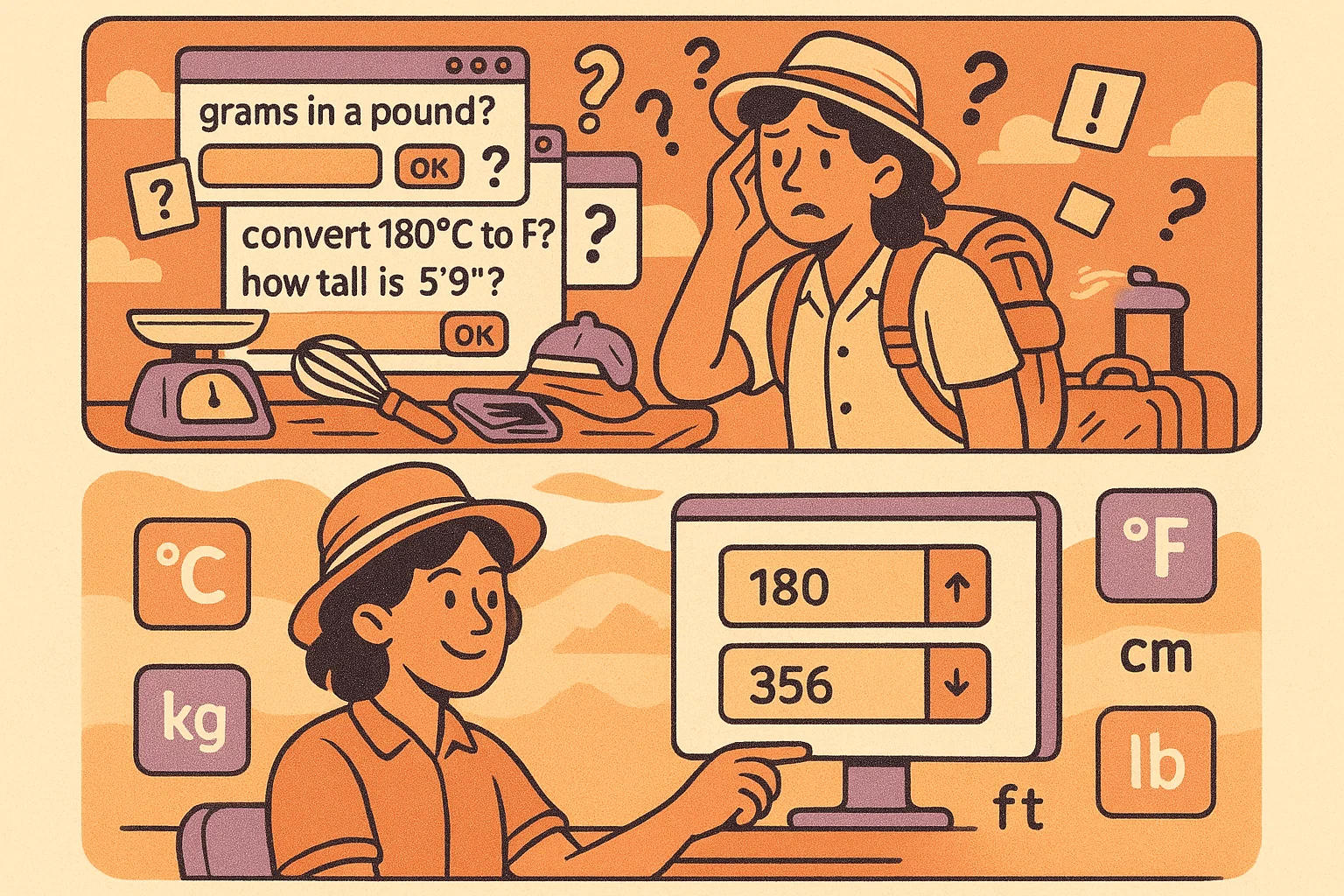Conversion may seem like a technical task, but it shows up in daily life more often than you'd think. Whether you're cooking with a recipe in grams, trying to understand kilometers on a road trip, or figuring out how cold 10°C really feels, conversion tools make it easy to switch between units without overthinking. These tools are built for real-world use — fast, accurate, and frustration-free, whether you're a student, traveler, or just getting things done.
Everyday Numbers, Different Systems: Why Conversion Still Matters
Even in a hyper-connected world, unit systems still divide us. One country uses feet, another uses meters. Your oven shows Fahrenheit, but the recipe says 180°C. It seems small—until you’re ordering furniture online, packing a suitcase for a trip, or trying to follow a baking tutorial from abroad.
These everyday situations often come with hidden math problems. How many grams in a pound? Is 5'9" taller or shorter than 175 cm? What’s the weight limit in kilos when your suitcase scale only shows pounds?
Instead of guessing, searching, and second-guessing, a Weight Converter or Length Converter gives you fast, accurate answers in one step. No mental math. No miscalculations. Whether you're a traveler, online shopper, student, or just someone trying to get things right the first time, having a reliable converter makes daily life smoother.
In a world of mixed systems, a good conversion tool is less about numbers — and more about clarity.
Cooking, Crafting, and DIY: When Precision Counts at Home
At home, precision sneaks up on you — in the middle of a cake recipe, a sewing project, or a batch of homemade candles. You’re following a tutorial or recipe that looks easy enough… until it tells you to add 250 grams of flour, and your kitchen scale only shows ounces. Or you’re cutting fabric that needs to be 50 cm long, but your measuring tape is in inches.
That’s the everyday challenge of unit mismatch. And when you’re baking or building something from scratch, a small error can throw the whole project off. Undercooked centers, crooked seams, wasted materials — all because the units didn’t match.
That’s where tools like the Cooking Converter and Volume Converter make life easier. Whether you're scaling recipes up or down or translating a European ingredient list, these tools give you quick, accurate conversions between teaspoons, cups, milliliters, and more — without flipping through pages or guessing.
And if your oven doesn’t match the temperature listed in the recipe? The Temperature Converter lets you jump between Fahrenheit and Celsius instantly.
For DIYers and home creators, small conversions make a big difference — and the right tools keep your projects on track.

Travelers, Expats, and International Students: The Quiet Friction of Moving Between Systems
Living abroad or traveling often feels like navigating a different language — and sometimes, that language is math. You’re driving in Spain, and the speed limit reads 120. Is that fast? You glance at your rental car’s dashboard — it’s in miles per hour. Now what?
This kind of small confusion happens constantly when switching between unit systems. Road distances are measured in kilometers, but you’re used to miles. Weather apps give temperatures in Celsius, but your brain still thinks in Fahrenheit. You stop to refuel, and the pump measures in liters — but you have no idea how that translates to the gallons you’re familiar with.
These aren’t life-or-death problems, but they create a steady drip of friction — especially for travelers, international students, digital nomads, or expats adjusting to a new environment.
With tools like the Speed Converter, you can instantly check if you’re over the limit or comfortably cruising. The Distance Converter helps you understand how far that next stop actually is. And the Fuel Consumption Converter lets you compare MPG to L/100km, so you’re not lost when renting a car or reading a fuel estimate abroad.
These conversions take seconds, but they add up to smoother days, fewer surprises, and more mental space for everything else — like enjoying the journey.

Data Isn’t Just for Developers Anymore
In today’s digital world, even non-technical users run into data units. You’re uploading assets to a website, exporting a design file, or trying to understand why your cloud storage is full — and suddenly you’re asking, What’s the difference between MB and MiB?
It’s not just developers dealing with this. Freelancers, marketers, students, and content creators constantly juggle files, speeds, and sizes — even if they don’t realize it. A video editor might need to convert gigabytes to megabytes before exporting; a social media manager might be comparing image sizes; and a student might be trying to make sense of download speeds shown in Mbps vs. MB/s.
The Data Storage Converter, Data Transfer Converter, and Bit–Byte Converter help take the guesswork out of modern file handling. They give you quick, accurate answers when you’re planning backups, estimating bandwidth, or double-checking delivery specs.
You don’t need to memorize the math — just use the right tool, and get on with your work. Because in the modern workplace, understanding digital units isn’t optional anymore — it’s just part of staying sharp.
One Tool, Many Uses
From baking in your kitchen to navigating new countries, unit conversions show up in more places than we realize. Whether you’re adjusting a recipe, converting speed limits, estimating fuel, or working on a school project, these aren’t niche calculations — they’re everyday decisions.
That’s why having a reliable Converter Tool on hand just makes sense. It saves time, removes guesswork, and lets you move between systems without missing a beat. No cluttered interfaces. No confusing ads. Just clear, fast answers whenever you need them.
You don’t have to be a scientist or a student to care about accuracy. You just need tools that work — wherever life takes you.
